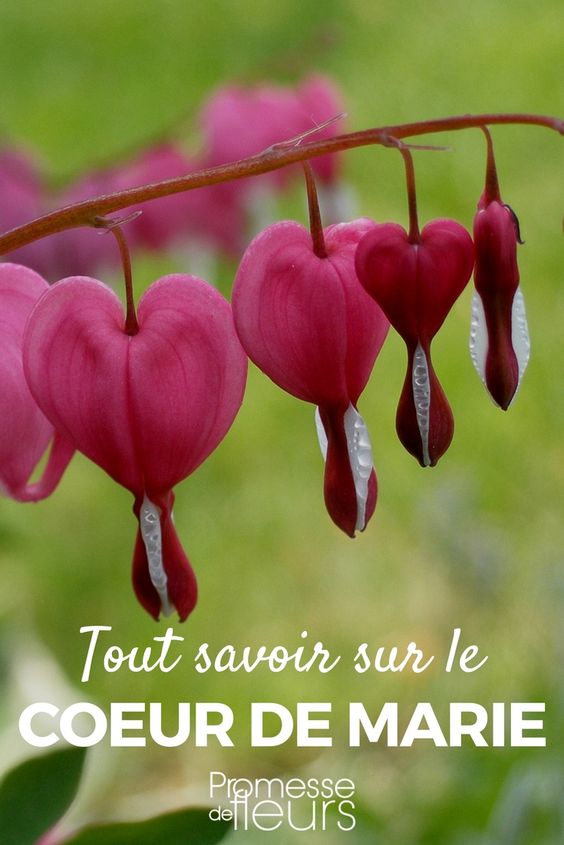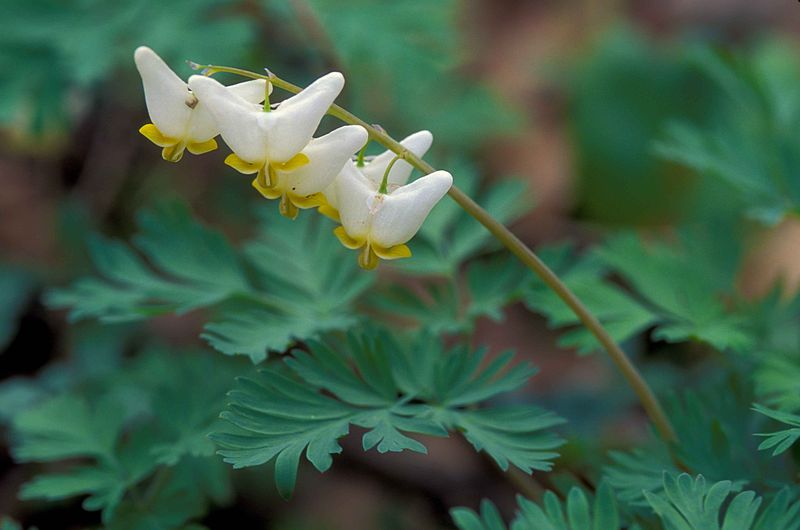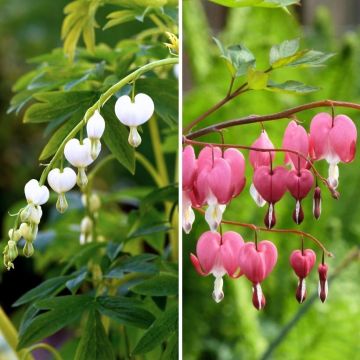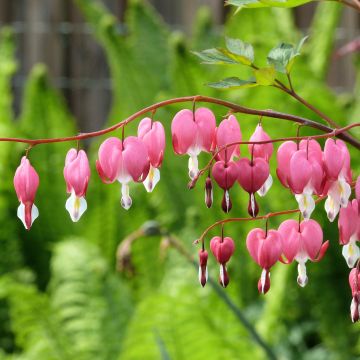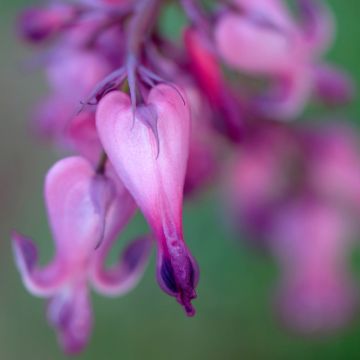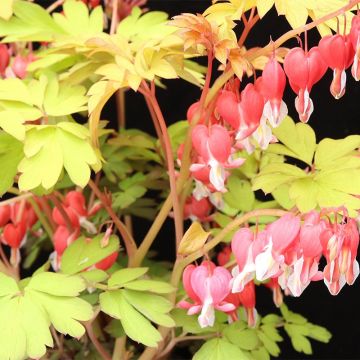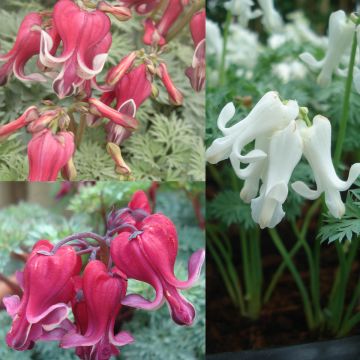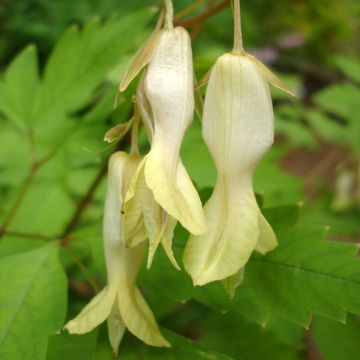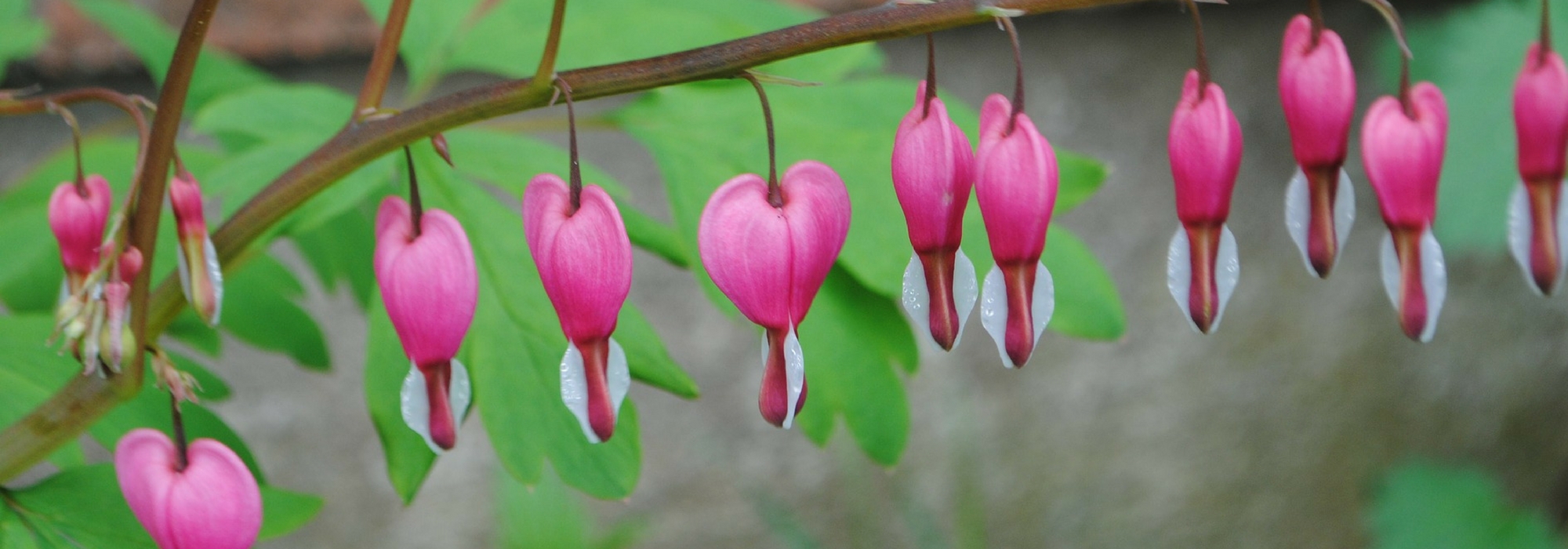
Bleeding heart: planting, cultivation and companion planting
Contents
Bleeding heart in a nutshell
- Bleeding heart is one of the centrepieces of cool, shady gardens.
- Its lovely heart-shaped flowers in white, pink, or red, delicately suspended on their arching stems, appear generously from April to June.
- It has magnificent, opulent foliage, finely divided in soft green or glaucous, resembling that of ferns.
- Easy to grow and very frost-resistant, it fears only two things: drought in summer and excess water in winter.
- Once well-rooted in cool soil, it requires very little care.
- Emblematic of cottage gardens or English mixed borders, it is our favourite spring plant!
A word from our expert
The Bleeding Heart, also known as Lamprocapnos spectabilis, is a perennial plant with lush, finely dissected foliage in soft green or blue-grey, notable for its floribundity. Its flowers are among the most graceful of spring blooms. While Dicentra spectabilis is the most iconic, Dicentra formosa and Dicentra eximia, are two beautiful groundcover species whose foliage is delicate and light, reminiscent of ferns or chervil.

The flower of Dicentra spectabilis or Bleeding Heart
Its flowers, pendulous and shaped like small hearts in white, pink, or red, brighten shaded gardens with their lightness from April to June.
Introduced into ornamental gardens long ago, it has managed to endure generations of gardeners without going out of style. Its remarkable simplicity makes it a staple in cottage gardens and English mixed borders, where it brings freshness and lightness. Delicate and opulent, it is one of the focal points of shady gardens, white gardens, and English cottage gardens, often found in fresh and romantic white/pink combinations with other perennials.
Hardy and easy to grow, this beauty of the undergrowth finds its place in a mass planting under large trees, along pathways, or in pots on a shaded terrace or balcony.
It thrives in a community alongside vigorous perennials that will take over and are not afraid of competing with the roots of trees or bushes: the Bleeding Heart enjoys the company of ferns and hostas, with which it forms lush beds. It will be paired with spring bulbs, tulips, muscari, or hyacinths, and mixed with groundcover perennials like Euphorbia cyparissias, Caucasian forget-me-nots, heucheras, and tiarellas.
With its charm, resilience, and the uniqueness of its flowers and leaves, the Bleeding Heart is a lovely, low-maintenance plant that is sure to enchant you, whether you have a garden or not.
Description and Botany
“`html
Botanical data
- Latin name Dicentra spectabilis
- Family Papaveraceae (Fumariaceae)
- Common name Bleeding Heart, Lady's Heart
- Flowering April to June
- Height 20 cm to 60 cm for the most common species, up to 3 m for D. scandens, a climbing species
- Exposure sun, partial shade
- Soil type heath (acid), neutral
- Hardiness Hardy to -15°C but sensitive to late frosts
The Dicentra spectabilis, commonly known as “Bleeding Heart” or “Lady’s Heart,” is native to North America and Asia, and can also be found in Siberia. In its natural habitat, this plant grows in moist environments and mountainous forests, forming large clumps with finely divided foliage. In France and Europe, it is found up to 1800 m in altitude.
It belongs to the extensive family of Papaveraceae (formerly Fumariaceae), which includes nearly 200 species of predominantly herbaceous plants. The Bleeding Heart is a cousin of the poppy, fumitory, and celandine, sharing its beautifully lobed grey-green foliage. In Greek, Dicentra means “two spurs,” referring to the unique shape of its flowers with oddly turned outer petals.
The genus includes over 20 perennial and annual species, among which Dicentra spectabilis, the most common, Dicentra formosa and Dicentra eximia, two beautiful groundcover species, and even Dicentra scandens, a climbing form reaching up to 3 m in height.
The Bleeding Heart has a bushy, clump-forming habit. Heights vary depending on the varieties: between 30 and 60 cm, with similar spread, sometimes more for the climbing types, which, once well-rooted, can reach over a metre in height and width.

Varieties ‘Goldheart’, ‘Burning Heart’ and ‘Ivory Hearts’
The Bleeding Heart propagates easily through its creeping rhizomes, tubers, or thick fleshy roots, depending on the species. Groundcover species like Dicentra formosa and D. eximia spread quite widely as their rhizomes tend to weave among neighbouring plants. Some annual and biennial species also practice abundant self-seeding. The growth of the Bleeding Heart is moderately fast: it takes between two to five years to reach full development and form a dense clump. However, once well established, it can live for several decades as long as it is not moved. It does not like to be disturbed; its rhizome is very brittle and therefore fragile.
The Bleeding Heart produces very distinctive flowers, remarkable for their originality and delicacy. From its finely divided foliage, long arching flower spikes emerge from April, bearing at their tips panicles or clusters of 3 to 15 pendulous flowers resembling little hearts. These flowers, usually bright pink, can also be pure white or shaded mauve, purple, golden yellow, or red depending on the species. The flower is narrow and flattened, measuring 3 to 5 cm high and 2 to 3 cm wide. The typical species features an irregular corolla made up of pink outer petals, heart-shaped with two more or less turned spurs, and white inner petals shaped like arrows. These tips can be tinted in various colours, including white, pink, yellow, or violet, creating bi-coloured bells. A unique architecture that makes the plant one of a kind.
The remarkably generous flowering begins in April-May. It lasts between three weeks and a month.
Each fertilised flower produces a pod that yields round black seeds surrounded by a white mucilage.
The foliage of some varieties is as interesting as the flowering. While that of D. spectabilis is magnificent and lush, the creeping varieties, Dicentra formosa and D. eximia have lovely finely divided decorative leaves. Delicately cut, light, and elegant, their foliage resembles that of ferns or chervil.

Bleeding Heart: foliage of the varieties ‘Burning Hearts’, alba and ‘Goldheart’
Deciduous, it disappears in winter. In March-April, as soon as the temperature warms up, the leaves begin to emerge from the ground. The clump then produces tall, somewhat fleshy shoots that will become long twigs laden with flowers by May-June. The upright stems, often very branched, are usually light green but can take on a reddish or purplish hue, depending on the varieties. They display, depending on the species, beautiful shades of green, ranging from light green to dark green, golden green, or bluish-grey to silvery. The leaves are highly divided, pinnate or trilobed. Very fine in appearance, they measure 20 to 50 cm. As they spread, they add a certain lushness to the plant. Beautifully composed, they provide a lovely backdrop for the flowers.
After flowering, as summer sets in, the plant will gradually enter dormancy: the foliage wilts and yellows, disappearing and leaving a large void in the flowerbeds. It follows its normal vegetative cycle and sleeps to protect itself from drought. It will reappear the following spring.
This perennial, native to woodlands, enjoys cool, shaded environments; it does not like direct sunlight. Therefore, it should be placed where it receives only a few hours of sunlight per day. It will thrive easily in partial shade, exposed to morning or evening sun and planted under the canopy of deciduous trees that will provide beneficial coolness. Too dense shade would limit its flowering. The wind from spring showers could harm its delicate shoots: provide it with a sheltered spot. It can tolerate sunny exposure (except in southern regions) if the soil remains sufficiently moist and cool with good mulch in summer.
It is a plant of temperate climates that does not like summer drought or excess water in winter. Very tolerant of soil type, Dicentra spectabilis flourishes in light, humus-rich soil, moist to dry in summer, well-drained, neutral to acidic.
The apparent lightness of the flowers may suggest that these are very fragile plants, but this is not the case. This very cold-resistant and vigorous perennial can be planted anywhere in France. Very hardy, it withstands the lowest temperatures, around -15°C. Some varieties can endure prolonged periods below -30°C. However, the young foliage is sensitive to late frosts: it can happen that the first spring shoots, which emerge too early, freeze, but others will regrow a little later.
Thus, it is an ideal plant for challenging situations. Essential in gardens in northern France, it thrives best in regions with cool summers.
The Bleeding Heart is a perfect plant for borders, rockeries, but also to enliven balconies or terraces. In the garden, avoid planting in groups: in summer, the Dicentras leave an unsightly void in the flowerbeds. Pair them with ferns, hostas, which will take over. Dress the base of shrubs in spring with spring-flowering bulbs like tulips, daffodils, cyclamen, or a carpet of lily of the valley, forget-me-nots, or periwinkles. It can be combined with other perennials that do not fear competition from tree or shrub roots. Accompany it with hardy fuchsias, creeping purple bugle, Japanese anemones, or purple foxgloves.
The Bleeding Heart is very resistant to diseases and pests but is susceptible to aphids, snails, and slugs.
“`
Botanical species
The bleeding heart is a plant that has been introduced into ornamental gardens for quite some time. Originally, around twenty species of Dicentra were distinguished, but today eight are recognised, including Dicentra spectabilis, the most common, D. canadensis, D. cucullaria, Dicentra formosa, and Dicentra eximia, two beautiful groundcover species, as well as D. peregrina. Dicentra scandens is a climbing form. The two South American species, Dicentra formosa and D. eximia, are nearly identical and often confused.
The main selection criteria are the colour of the flowers and the shade of the foliage. The heights, heterogeneous from one species to another, can also guide the choice.
- Dicentra spectabilis: this is the best-known and most common species in gardens. This large perennial with fleshy roots bears sumptuous pale pink flowers with white tips, suspended on arching stems. They stand out against elegant large leaves measuring 15 to 40 cm, which are finely dissected and light green.
- Dicentra eximia: this rhizomatous perennial forms beautiful carpet-like clumps of grey-green, finely dissected leaves resembling those of chervil or ferns. Panicles or clusters of inclined flowers in shades of pink, magenta, or white emerge. Its flowers are longer and more elegant than those of D. formosa, with which it is often confused.
- Dicentra formosa: this widely spreading rhizomatous plant has green leaves with a bluish underside, providing a beautiful contrast with the pink clusters of flowers that become almost white with age. It spreads easily, forming vast colonies and weaving between the stumps of other plants. It is less tolerant of hot, humid summers than D. eximia.
- Dicentra scandens: this is a climbing and voluble perennial that climbs sheltered walls and fences, reaching heights of up to 3 m. Its medium green foliage is deeply dissected, contrasting with bright yellow or white flowers, sometimes tinged with purple or pink at the tips.
- Dicentra cucullaria: while its deeply dissected blue-green foliage does not differ from that of other species, its flowers, on the other hand, have a triangular shape resembling a hood or airplane wings, white with a yellow tip rather than small hearts. Unlike other species in the genus, it is an ephemeral that wilts and disappears quickly after flowering. It is not widely cultivated in our latitudes… but is nonetheless charming!
Discover other Dicentra - Bleeding Hearts
View all →Available in 0 sizes
Available in 3 sizes
Available in 3 sizes
Available in 2 sizes
Available in 3 sizes
Available in 1 sizes
Available in 1 sizes
Available in 0 sizes
Available in 1 sizes
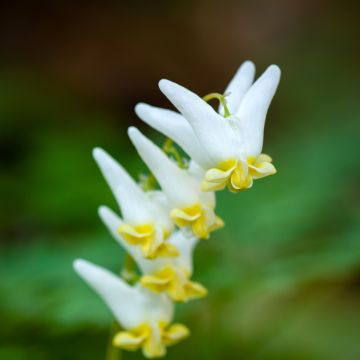
Available in 1 sizes
Main varieties
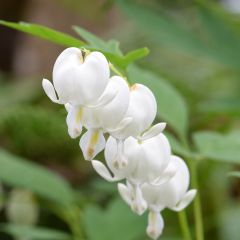
Dicentra spectabilis Alba
- Flowering time May to July
- Height at maturity 60 cm
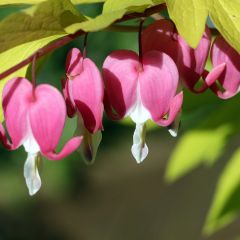
Dicentra spectabilis Goldheart
- Flowering time June, July
- Height at maturity 60 cm
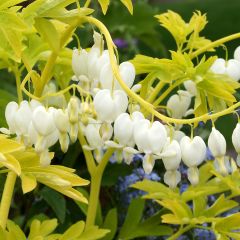
Dicentra spectabilis White Gold
- Flowering time June, July
- Height at maturity 60 cm
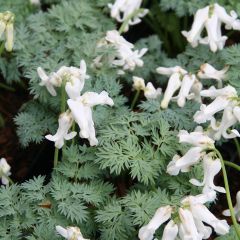
Dicentra Ivory Hearts
- Flowering time June to October
- Height at maturity 30 cm
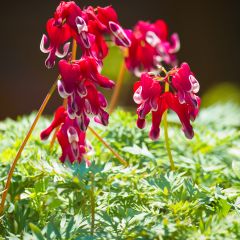
Dicentra Burning Hearts
- Flowering time June to October
- Height at maturity 40 cm
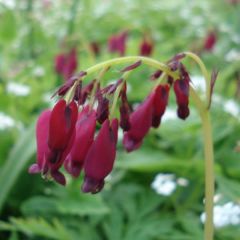
Dicentra formosa Bacchanal
- Flowering time June to October
- Height at maturity 30 cm
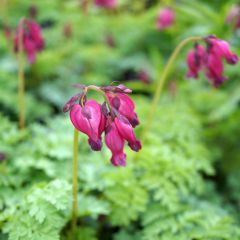
Dicentra King of Hearts
- Flowering time June, July
- Height at maturity 30 cm

Dicentra formosa Aurora
- Flowering time June, July
- Height at maturity 25 cm
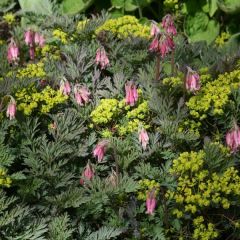
Dicentra Stuart Boothman
- Flowering time June to October
- Height at maturity 25 cm
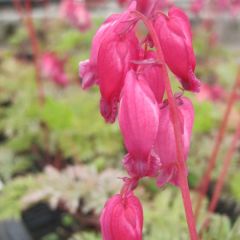
Dicentra formosa Luxuriant
- Flowering time June to October
- Height at maturity 30 cm

Dicentra formosa Bacchanal
- Flowering time June to October
- Height at maturity 30 cm

Dicentra Stuart Boothman
- Flowering time June to October
- Height at maturity 25 cm

Dicentra Ivory Hearts
- Flowering time June to October
- Height at maturity 30 cm
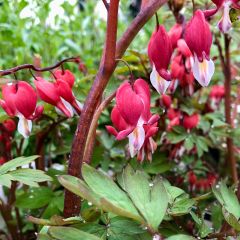
Dicentra spectabilis Valentine
- Flowering time June, July
- Height at maturity 35 cm
Planting
Where to Plant the Bleeding Heart?
It can be planted anywhere in France. Very hardy, it withstands temperatures around -15°C, sometimes even lower in sheltered situations.
It is an easy plant, provided it is installed in deep, cool, humus-bearing soil, preferably neutral or acidic, and well-drained. It only fears excesses: too much water in winter and too much sun in summer. It thrives best in cooler regions.
It prefers to be planted in partial shade, with a few hours of sun in the morning or late afternoon, or under dappled sunlight from deciduous trees. The Bleeding Heart has a great quality: it can grow in soils riddled with roots, beneath trees, without them hindering its development. It can tolerate sunny exposure (except in southern regions) if the soil remains sufficiently moist and cool in summer. Good light is essential for its flowering. However, we recommend planting it where it can express its full potential: protected from scorching direct sunlight under the light shade of a tree, in cool soil, and sheltered from prevailing cold winds.
Once established, avoid moving it, as it takes several years to reach its full development.
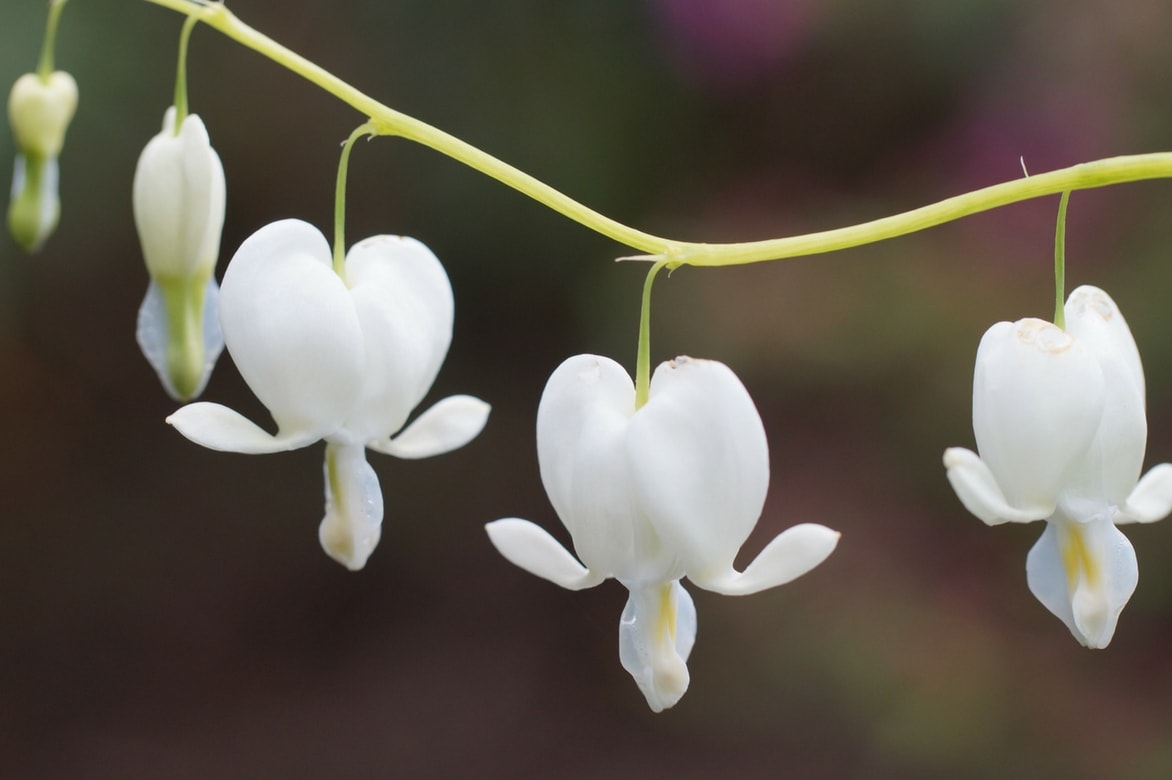
White Bleeding Heart – Dicentra alba
Growing in a pot is easy as long as you don’t neglect watering. Plant it in a pot of at least 30 cm, in rich, humus-bearing soil, and it will become magnificent, provided you never let the soil dry out… or become waterlogged!
When to Plant?
The Bleeding Heart can be planted in spring (around March) after the frosts or in autumn (in September). Planting in autumn encourages rooting before winter.
How to Plant?
Once well established, the Bleeding Heart requires little care. The secret to this elegant, vigorous perennial lies in the planting.
It needs light, well-draining, rich soil that remains cool in the heart of summer: if necessary, add well-decomposed compost and a bit of sand for drainage. Some species do not tolerate clay soils.
For plants in pots: moisten the root balls by submerging them in a basin of water until no more air bubbles escape. Both the leaves and roots are fragile and can be crushed. During transplantation, do not disturb the root ball.
Dig a hole that is wide and deep enough. Maintain a spacing of 40 cm between each plant. Plant in groups of 3 or 4 for a beautiful effect, no more. Avoid planting too many Dicentras, as they would leave an unsightly gap in summer. Pair them with ferns, hostas, Japanese anemones, corydalis, heucheras, and ophiopogons that will take over in the border. Firm the soil. Keep the soil cool with mulch, especially during summer; this is the guarantee of prolonged flowering. Water regularly in the first summer to encourage rooting. Protect them from slugs. And let it be: the established plant prefers not to be disturbed.
To learn everything about planting this lovely perennial, discover our advice sheet: “Bleeding Heart: Succeeding in Its Planting”
Maintenance and pruning
Bleeding heart is not very demanding and requires little maintenance.
During the flowering period, faded flowers can be cut back as they appear to encourage the emergence of new blooms.
No pruning is necessary. After flowering, the plant will gradually enter dormancy, and the foliage will yellow. You can either leave it in place or simply cut back the unsightly faded stems during the summer.
In summer, the soil should remain cool. Mulching around the base helps to keep the plant cool and promotes flowering, especially in the hottest regions. Mulching can also be beneficial at the end of winter to combat late frosts, which young plants are very sensitive to. You can apply fertiliser at the end of spring.
Bleeding heart is a very disease- and pest-resistant plant. However, its young shoots are susceptible to aphids and gastropods. Fern manure can help combat slugs and snails.
Potted specimens can be enriched with compost each year.
Multiplication
Propagation of the plant is carried out by sowing seeds, by propagation by cuttings of stems or roots, an alternative to be done in winter.
Sowing
Home sowing is sometimes not homogeneous, and the colours may differ from the parent plant. Root or stem cuttings are less random and allow for the preservation of the original hues. These perennials are relatively easy to grow from seed. Sowing is done in autumn with this year’s seeds before they dry out, when they are fresh, just out of the pods. Sow under a cold frame in a sandy mix. Plant the seeds 6mm deep. Allow 2 months for germination. Transplant when the seedlings have strengthened, when they reach 5 cm in height.
Division
Clump division is possible but delicate; it should be done when the plant is dormant, preferably in summer after flowering or in autumn, but we do not recommend it. Bleeding heart does not appreciate having its very fragile rootstock disturbed, and the risk of damaging it is considerable.
Root Cutting
Root cuttings are done in winter, working carefully to avoid damaging the very fragile fleshy roots of the bleeding heart. It is necessary to completely lift the parent plant from the ground: use a fork to lift the stump. Be careful not to break the large roots. With pruning shears, take a piece of vigorous and healthy root about 8-10 cm long. Replant the parent plant immediately. Under a frost-free frame, plant the cuttings deeply and vertically in a light substrate made of a mix of potting soil and sand. Mist regularly to maintain reasonable moisture (not too much: you would rot the roots). In April-May, stems will begin to appear. Transplant each cutting into a pot and let the beautiful season pass. They must not suffer from drought: ensure proper watering. In early autumn, transplant the plants directly into the ground.
Stem Cutting
Cut a healthy stem with leaves, about fifteen centimetres below a bud. Remove the lower leaves to prevent them from rotting. Place the cutting in a mix of garden soil, potting soil, and sand.
Association
With its profusion of flowers, the bleeding heart ensures a very floral spring and early summer. It is even inspiring for creating a naturalistic garden, featuring plants that require little care and maintenance.
Delicate and opulent, it flourishes in a variety of styles, bringing elegance and originality to garden beds. It is one of the centrepieces of shady gardens and English cottage gardens, where it can be found in fresh and romantic white/pink combinations with other perennials.

With daffodils and tulips – Copyright – GAP Photos – Mark Bolton / In white undergrowth with astrantias and tiarellas – Photo Credit GAP Elke Borkowski-092014
To elevate the tone in the beds, red varieties will be paired with the strong or warm colours of a hardy geranium ‘Bob’s Blunder’, chocolate tulips, or a Spigelia marilandica with bright red tubular flowers.
In the garden, avoid planting in groups: in summer, the Dicentra leave an unsightly gap in the borders. It will thrive in a community alongside robust perennials that are not afraid of competing with the roots of trees or bushes and will take over. For a beautiful foliage effect in a bed, it is often associated with the fronds of ferns, with which it shares the finely cut leaf shape, or placed near plants with glaucous foliage like hostas.
Pair it with the large yellow pendulous bells of an Uvularia grandiflora, purple creeping bugle, hellebores, or foxgloves.
In the background of a shady bed, it will shine alongside the colourful foliage of purple heucheras, hardy geraniums, and alongside astrantias, columbines, a lady’s smock, or a silver lamium in magenta or white.
For an elegant spring display, plant bulbous flowers at its base: fresh-coloured tulips, white daffodils, candelabra primroses. The glaucous hue of its leaves will enhance the pure blue of Caucasian forget-me-nots and periwinkles or the purple of pasque flowers or Siberian irises. It will also form a charming setting for lily of the valley and mini cyclamen that require the same growing conditions.
In a pot, it will be perfect as a solitary specimen, its opulent foliage and profusion will be enough to enliven a shaded terrace or balcony.
In a romantic or naturalistic version, in a pot, discover our successful pairing ideas and let yourself be inspired!
Useful resources
- The prettiest varieties of Bleeding Heart are with us, discover them!
- Our expert, Michaël, discusses Dicentra ‘King of Heart’, an amazing new variety of Bleeding Heart.
- Advice sheet: Choosing a Bleeding Heart
- Advice sheet: Bleeding Heart, the most beautiful varieties
Frequently asked questions
-
Is my bleeding heart turning yellow in summer, is that normal?
Yes, this is perfectly normal; it is a natural phenomenon. The foliage of the bleeding heart gradually yellows and wilts during summer, around July-August, when the flowering ends. The plant enters dormancy, and its growth will resume the following spring.
-
It's the beginning of March and my bleeding heart isn't shooting, why?
It's still a bit early. The season is still cold, and the bleeding heart, although hardy, is slow to wake up. This is quite typical for this time of year. Next month, small shoots will start to emerge from the ground. By May, you will be able to enjoy its flowering.
-
My bleeding heart is stagnating; what is the best time to move it?
Bleeding heart does not like to be moved as it takes time to settle in properly. However, if its location does not seem to suit it, it is indeed better to transplant it. It is advisable to wait until autumn to do so. It should be moved with great care, as bleeding heart has very deep, fragile, and brittle roots.
-
Should you cut back or prune Dicentra spectabilis?
There is no need to prune it; pruning is unnecessary. After flowering, simply cut back the faded stems that detract from its aesthetic appearance.
-
Can you divide the bleeding heart?
The plant does not tolerate having its fragile rootstocks disturbed. We advise against dividing the clumps. Taking cuttings from the roots is preferable and less risky.
- Subscribe!
- Contents
